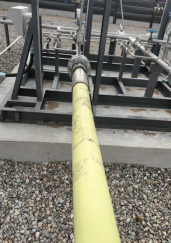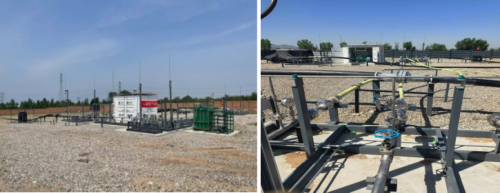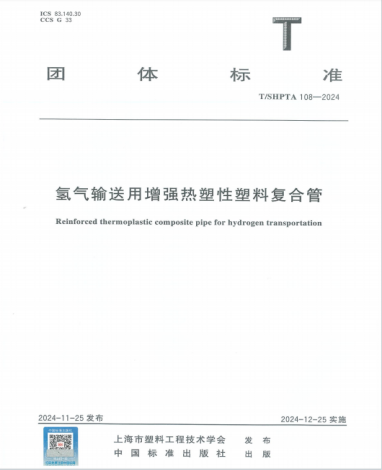2025-07-28
While Europe and the United States are weighing the transition between traditional energy sources and hydrogen energy, China has positioned hydrogen energy as the ‘petroleum zero-carbon era’, competing for the right to define the next-generation energy system.

On January 1, 2025, the Energy Law of the People's Republic of China will come into force - for the first time, hydrogen energy will be incorporated into the legal system as a “national strategic energy source”, marking that this green and clean energy source is officially tasked with reshaping China's energy landscape. However, the transportation of hydrogen has always been a technical barrier in moving from the lab to practical applications. Hydrogen gas with its small molecular weight is prone to leakage and has extremely high requirements for the gas tightness and strength of pipelines. Conventional steel pipes are susceptible to hydrogen embrittlement when exposed to high-pressure hydrogen for a long period of time - hydrogen atoms penetrate into the metal lattice, resulting in a sudden drop in toughness, weakening of the material strength and even cracking, creating a major safety risk. As a result, in the frenzy to solve the carbon-neutral puzzle, hydrogen transportation has become a bottleneck problem that has attracted much attention but few breakthroughs.
However, flexible composite pipeline with its polymer lining layer of excellent impermeability and anti-hydrogen embrittlement performance, combined with high-strength fibers to provide the required pressure-bearing capacity, is becoming a breakthrough in the bottleneck of hydrogen transportation, to ensure the safety of large-scale delivery of the key technology direction.
With the concept of “building the foundations for safe transportation of hydrogen energy”, ZTOC is committed to the developmen of an indispensable energy transportation pipeline. Since 2022, ZTOC has formally launched the research and development of core technology of hydrogen transportation pipeline through deep-rooted flexible pipeline design and manufacturing technology and integration of local government industrial support and other multi-faceted resources, and is committed to designing a safe and reliable hydrogen transportation pipeline system for the key links in energy transportation by tackling the design of pipeline and transmission process for the characteristics of hydrogen energy. Meanwhile, through cooperation with China University of Petroleum and Tehi Hydrogen Detection (Baoding) Co., Ltd, ZTOC has conducted in-depth research on the molecular behavior, aging mechanism and structural response characteristics in hydrogen environment from the material level, which ensures that each flexible pipeline has the best balance of safety, durability and economy. By the current research cycle, ZTOC has successfully developed thermoplastic reinforced composite pipes for hydrogen transportation and has mastered a number of key core technologies, and some of the results have successfully filled the gaps in the country.
At the moment, ZTOC has completed the research, development and performance verification of several types of flexible hydrogen pipelines, and has realized initial landing applications in many fields. Relying on the first comprehensive test platform for 10MPa hydrogen transmission pipelines in China built by the Central Research Institute of State Power Investment Corporation, the company has carried out the adaptability evaluation test of DN50 and DN80 hydrogen transmission pipelines under actual working conditions of 10MPa, and utilized online hydrogen permeation test instruments, hydrogen-sensitive tapes and other equipments and tools to monitor the hydrogen permeability of the pipes and joints on a timely basis.

At the same time, the key properties of the pipe, such as rapid pressure relief stability and compatibility with hydrogen medium, are also comprehensively evaluated. It is fully verified that the hydrogen pipeline has stable process structure and excellent permeability, the joints provide good sealing and safety, and it has the ability to transport hydrogen for a long period of time under actual working conditions, which provides a key guarantee for the long-distance transportation of high-pressure hydrogen.

In the development of industry standards, ZTOC, as one of the group standard drafting and national standard editing entities in the field of hydrogen energy pipeline, not only took the lead in the development of T/SHPT 108-2024 “Thermoplastic Reinforced Composite Pipes for Hydrogen Transportation” and T/CAOE “Submarine Hydrogen Transmission Flexible Composite Pipes”, but also participated in the formulation of many hydrogen transmission pipeline standards such as National Standard 20243274-T-607 “Plastic Composite Pipe for Hydrogen Transportation” and T/SHPT “Performance Test and Applicability Evaluation of Flexible Hydrogen Transmission Pipes”.
At this stage, ZTOC Flexible Hydrogen Pipeline has been deployed in several green hydrogen production bases, wind-solar hydrogen storage integration demonstration projects, hydrogen port supply systems, with significant advantages such as coiling of pipelines, convenient installation, low maintenance costs, adaptation to complex terrain, etc. It has become a key carrier for breaking through the limitations of traditional rigid steel pipes and realizing safe and efficient transportation of hydrogen in medium and long distances.
Oriented to the future, ZTOC will continue to enhance the strategic layout of hydrogen energy. On the one hand, ZTOC will continue to increase investment, leading the construction of the next generation of non-metallic flexible hydrogen pipeline standard system covering land, submarine and hydrogen blending scenarios; on the other hand, ZTOC will continue to promote the substitution of localization of core materials and the construction of an intelligent pipeline monitoring platform, to help our country build a closed-loop ecosystem of hydrogen energy, including “hydrogen from renewable energy sources, efficient and safe transportation, and diversified end-use”.
01-01
12-30
12-29
12-29
12-29
12-29